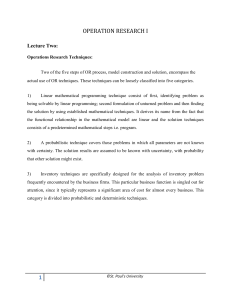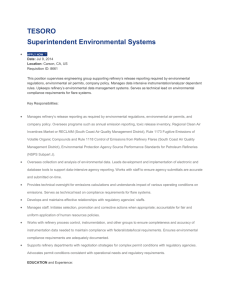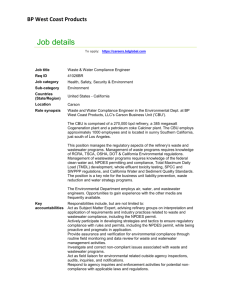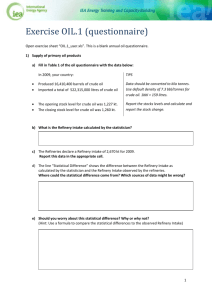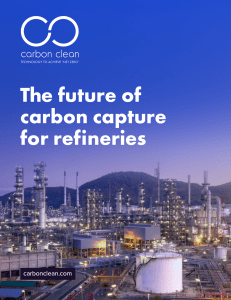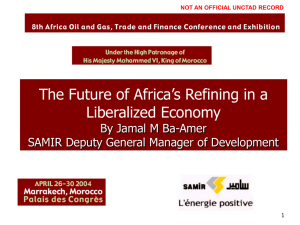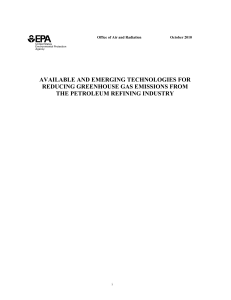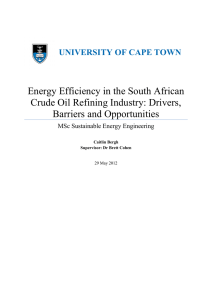Anand Kumar_IOCL
advertisement
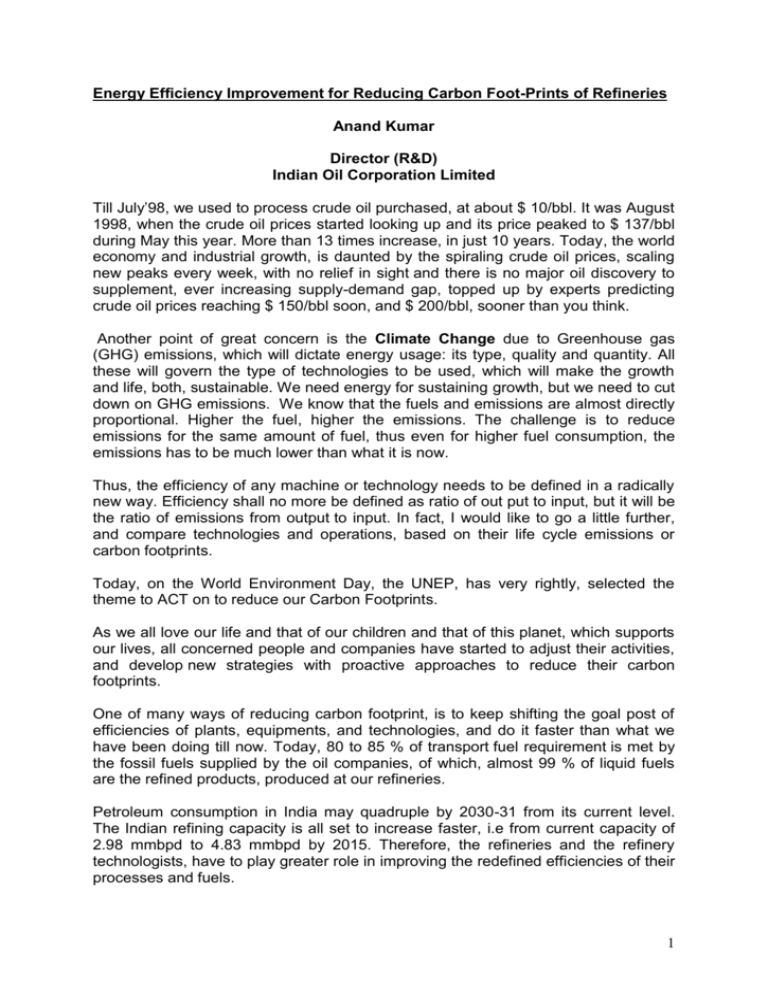
Energy Efficiency Improvement for Reducing Carbon Foot-Prints of Refineries Anand Kumar Director (R&D) Indian Oil Corporation Limited Till July’98, we used to process crude oil purchased, at about $ 10/bbl. It was August 1998, when the crude oil prices started looking up and its price peaked to $ 137/bbl during May this year. More than 13 times increase, in just 10 years. Today, the world economy and industrial growth, is daunted by the spiraling crude oil prices, scaling new peaks every week, with no relief in sight and there is no major oil discovery to supplement, ever increasing supply-demand gap, topped up by experts predicting crude oil prices reaching $ 150/bbl soon, and $ 200/bbl, sooner than you think. Another point of great concern is the Climate Change due to Greenhouse gas (GHG) emissions, which will dictate energy usage: its type, quality and quantity. All these will govern the type of technologies to be used, which will make the growth and life, both, sustainable. We need energy for sustaining growth, but we need to cut down on GHG emissions. We know that the fuels and emissions are almost directly proportional. Higher the fuel, higher the emissions. The challenge is to reduce emissions for the same amount of fuel, thus even for higher fuel consumption, the emissions has to be much lower than what it is now. Thus, the efficiency of any machine or technology needs to be defined in a radically new way. Efficiency shall no more be defined as ratio of out put to input, but it will be the ratio of emissions from output to input. In fact, I would like to go a little further, and compare technologies and operations, based on their life cycle emissions or carbon footprints. Today, on the World Environment Day, the UNEP, has very rightly, selected the theme to ACT on to reduce our Carbon Footprints. As we all love our life and that of our children and that of this planet, which supports our lives, all concerned people and companies have started to adjust their activities, and develop new strategies with proactive approaches to reduce their carbon footprints. One of many ways of reducing carbon footprint, is to keep shifting the goal post of efficiencies of plants, equipments, and technologies, and do it faster than what we have been doing till now. Today, 80 to 85 % of transport fuel requirement is met by the fossil fuels supplied by the oil companies, of which, almost 99 % of liquid fuels are the refined products, produced at our refineries. Petroleum consumption in India may quadruple by 2030-31 from its current level. The Indian refining capacity is all set to increase faster, i.e from current capacity of 2.98 mmbpd to 4.83 mmbpd by 2015. Therefore, the refineries and the refinery technologists, have to play greater role in improving the redefined efficiencies of their processes and fuels. 1 In future, Oil companies which are able to improve energy efficiencies of existing processes and adopt technologies, which are energy efficient and environment friendly, will only be able to sustain their businesses. Refining operations are as such energy intensive. Further, demand for high quality fuels and necessity to process cheaper, high sulfur and heavy crudes, are forcing refiners to adopt more and more hydro-processing units, which further increase energy intensity of the refinery. A large variety of opportunities exist within petroleum refineries to reduce energy consumption, while maintaining or enhancing the productivity of the plant. However, selection of the most favorable energy efficiency opportunities will be refinery specific, which are always based on detailed study and analysis. Most of the refinery fuel is used in furnaces and boilers. While efficiencies of boilers have gone up to 92-93 %, the efficiency of hydrocarbon furnaces leaves scope for further improvements. Most of the refineries have already implemented APH systems, especially in Crude Distillation furnaces to increase efficiencies from around 75% to 90 %. There is still scope to increase it to 92 %+ and it must be done at the earliest. The technologists have to come out with still more efficient PAH systems and burners for the furnaces and boilers. It may even call for changing the stacks and stack metallurgy, in order to increase the heat recovery from the flue gases. It is not one time investment. We need to continue to maintain these levels of efficiencies and keep them improving. For this, following best practices to be adopted to maintain the furnace / boiler efficiencies at design level: Regular operation of soot blowers Periodic, but regular, chemical cleaning of flue gas side surfaces to minimize deposition in convection and radiation zones o Use of right type of fuel oil filters and heater for better burner operation o Ensuring good fuel atomization at all times o o Maximisation of feed preheat in process units is another area, which refiners should constantly review. Whenever a plant undergoes revamp, with attendant changes in feed rate, quality etc, Pinch technology must be applied to identify the bottleneck of highest efficiency of plant and equipment and the same to be removed. It has to be made part of the monitoring and optimization systems of the refineries. Low level heat recovery should also engage the attention of refiners. A case in point is use of column overhead vapors for heating crude oil as implemented only in some of the Indian refineries. Feasibility of heat integration between process units should also be considered at design stage itself with use of hot feed in down stream process units instead of cooling, storage and reheating. Best practices to be followed in this area are; o o Periodic performance monitoring of heat exchangers trains and coolers Periodic chemical cleaning of heat exchangers. 2 Isolating and cleaning of fouled exchangers Maintaining water velocities in condensers and coolers Maintaining cooling water quality through effective cooling water management program o Back flushing of coolers and condensers, whenever required o o o Maintaining optimum reflux ratios, low pressure operation, wherever possible, optimizing pump arounds are some of the operational best practices, which can reduce energy consumption. Advanced process control techniques have already been implemented in many refineries for optimization of yield and energy consumption. Hydrogen management in refineries can significantly reduce operating cost as well as energy consumption in hydrogen production. Use of hydrogen rich off gases in process units directly in other hydroprocessing units, wherever possible or recovery of hydrogen from off gases through PSA are economical options available for refineries. Modern FCC designs use power recovery turbines or turbo expander to drive compressor/ air blower. Power recovery turbines have already been installed in Hydrocrackers. Use of hollow FRP fan blades in cooling towers/ air coolers have significantly reduced energy consumption. Variable frequency drives are increasingly adopted in air coolers as well as ID/ FD fans for energy savings. A survey can be organized to identify pumps where higher pressures are generated than required for reduction of impeller size. To reduce Fugitive Emissions, use of double mechanical seals in pumps for light hydrocarbon services, like LPG, naphtha has become a rule, which improves safety as well. Efficiency improvements in steam generation, distribution and end-use provide major energy savings. Steam can be economically generated through waste heat recovery from flue gases and cogeneration with power from gas turbines. The cogenerated steam can further be used to drive steam turbine for additional power. Pressure reduction through PRVs should be avoided and use of back pressure turbines should be considered especially for services where turbo drives are preferred due to process safety considerations. Installation of capacitor banks for improving power factor also results in energy efficiency improvement. Condensate recovery is one area which has been neglected in most of the refineries. Condensate recovery at different pressure levels can generate additional flash steam at lower levels and hot liquid condensate can be used directly as make up to de-aerators. This will have additional benefit of cost and energy reduction in production of DM water. Use of proper selection of steam traps and their maintenance is key to saving precious steam. Double seals in floating roof tanks, vapour recovery from tank wagon and truck loading areas are some of measures that should be adopted to minimize fugitive 3 emissions. Use of Zero leak control valve (class VI) where required can significantly reduce refinery flaring. Flare gas recovery (or zero flaring), and new ignition systems with low-pilot-gas consumption can reduce the amount of flared gas considerably. Proper selection of insulations like mattresses, pre cast insulation for low temperature applications and calcium silicate insulation for high temperature applications can considerably reduce heat losses. An organization-wide energy management program is essential to create a foundation for improvement and to provide guidance for managing energy. This typically involves establishing an energy policy, creating a cross-functional energy team, developing a baseline performance, benchmarking to set goals for improvement, implementing energy saving schemes and assessing performance through regular reviews. Periodic energy auditing through in-house as well as external consultants and setting higher benchmarks is necessary to keep pace with best in the world. Improvement in energy efficiency will minimize carbon foot prints in refinery operations. Carbon credits could also be gainfully utilized through CDM to economically justify some of the energy conservation projects which otherwise are not viable. The performance of refineries of future shall, besides many other factors, shall be measured by its carbon footprints. We need to start transforming our refineries by taking them in to future, by adopting low carbon process and technologies and by supporting transport and auto sector to leave minimum carbon foot print. Their carbon footprint will include refiners and marketers as well. The refineries, in order to leave behind a very faint carbon footprint has to make their products carbonless, and operations with ZERO EMISSION, A TOTAL RECYCLE OF ITS EFFLUENTS, and today is the auspicious day to start. 4
